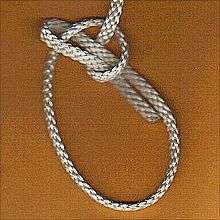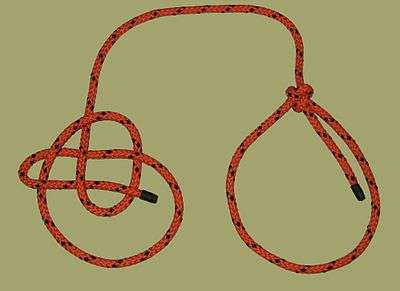Eskimo bowline
| Eskimo bowline | |
|---|---|
 | |
| Names | Eskimo bowline, Sitka loop, anti-bowline, Cossack knot, Kalmyk loop |
| Category | Loop |
| Origin | Ancient |
| Related | bowline, sheet bend, double bowline, water bowline, spanish bowline, triple bowline, bowline on a bight, running bowline, poldo tackle, cowboy bowline |
| Releasing | Non-jamming |
| Typical use | Placing a loop which will be stretched wide open under load in the end of a rope |
The Eskimo bowline is an 'anti-bowline' which is in a class of knots known as 'eye knots'. The eye is formed in the end of the rope to permit attachments/connections. The common (ABoK #1010) bowline is also an 'eye knot'. In the common bowline, the bight component forms around the 'standing part'. In contrast, the bight component of an anti-bowline forms around the ongoing eye-leg. The term 'eye' is consistent with eye bolt and eye splice. An eye bolt is not referred to as a loop bolt – it is properly termed an eye bolt. The same concept applies to an eye splice.

The Eskimo bowline is best used in applications in which the loop will be stretched wide. In applications where the two legs of the loop are nearly parallel, a bowline is superior.
The structure of the knot was not identified by Clifford Ashley (in 1944). All of the maneuvers to tie this knot are generally in the opposite (or 'anti' direction) relative to the bowline.
Dan Lehman regards the general, bowline-like structure as an 'anti-bowline' in the sense of "anti-clockwise": in that with regard to the main nipping loop, the tail on returning from forming the eye is brought through this loop in the opposite direction relative to what is done for a bowline. When this knot is ring-loaded – and the knot effectively becomes an end-to-end knot – it is effectively a sheet bend. (The image above with red rope would result in an ends-opposite (and inferior) sheet bend; the version shown on the right side would give a same-side sheet bend (ABoK #1431). The common bowline when ring-loaded becomes effectively an inferior version of the Lapp bend, and so can slip and untie; the wrongly demeaned "left-handed"/"cowboy" bowline becomes the proper Lapp bend, and should hold.)

A Cossack knot is another name for the same knot. A slipped version of the Cossack knot is called Kalmyk loop.[2][3]
See also
References